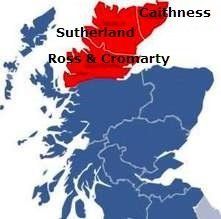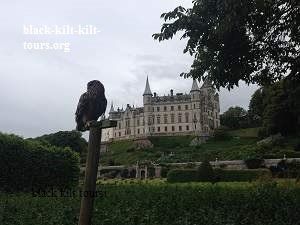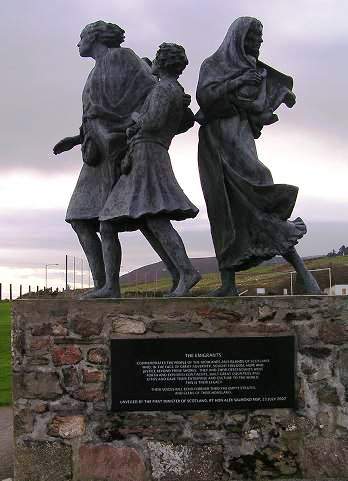Northern Scotland, Sutherland and Caithness

Sutherland
Sutherland is synonymous with the Highland Clearances: The forceful eviction of people from their homes of the mid- late 18th and early 19th centuries by the landowners to make way for large sheep farms. The Clearances were considered by the landlords as necessary "improvements". Sutherland suffered more than most parts of the Highlands, scattering people far and wide across the globe. The clearances also saw many forced to move from their inland homes to live along the north coast scraping a new life in fishing.


The inscription Reads:
"The Emigrants commemorates the people of the Highlands and Islands of Scotland who, in the face of great adversity, sought freedom, hope and justice beyond these shores. They and their descendants went forth and explored continents, built great countries and cities and gave their enterprise and culture to the world. This is their legacy. Their voices will echo forever thro the empty straths and glens of their homeland."
"The Emigrants commemorates the people of the Highlands and Islands of Scotland who, in the face of great adversity, sought freedom, hope and justice beyond these shores. They and their descendants went forth and explored continents, built great countries and cities and gave their enterprise and culture to the world. This is their legacy. Their voices will echo forever thro the empty straths and glens of their homeland."
The Highland Clearances
Dominating the skyline above the village of Golspie (and visible from many parts of east Sutherland) is the 100 foot tall statue on top of Ben Bhraggie. Erected in 1837 it is of George Granville Leveson-Gower, Marquess of Stafford and first Duke of Sutherland who became notorious through the part he played in the Highland clearances. The Duke of Sutherland's factor, Patrick Sellar, and his men carried out some of the most violent evictions, destroying homes and possessions to get his tenants out. Even today there is pressure to have the statue removed or blown up.
Strathnaver Museum: Strathnaver was the scene of some of the most brutal acts of the Highland Clearances, In fact it was from the very pulpit which dominates the centre of the Museum that the Rev. David Mackenzie was obliged to read out eviction notices to his congregation.
Strathnaver Museum: Strathnaver was the scene of some of the most brutal acts of the Highland Clearances, In fact it was from the very pulpit which dominates the centre of the Museum that the Rev. David Mackenzie was obliged to read out eviction notices to his congregation.
Caithness
The most northerly county on the Scottish Mainland. Duncansby Head is the most northerly point as you look out to sea at the Stacks of Duncansby.
The North-east tip of Scotland at the famous John o Groats is often the starting point for the long distance walk (874 miles - 1,407 km) to Lands End, Cornwall at the opposite end of the UK.
From Scrabster and Gill's Bay there are the ferries to Orkney.
Thurso is the northernmost town on the British mainland and home to the Caithness Horizons Museum in the former Town Hall
John o Groats takes its name from Jan de Groote, a Dutchman who obtained a grant for the ferry from the Scottish mainland to Orkney (acquired from Norway, by James IV, King of Scots, in 1496).
Peatland and Wetland: Straddling the two counties of Caithness and Sutherland is an area called The Flow Country it is the largest expanse of blanket bog in Europe, and covering about 4,000 square kilometres (1500 mile²). wikipedia.org/wiki/Flow_Country
The North-east tip of Scotland at the famous John o Groats is often the starting point for the long distance walk (874 miles - 1,407 km) to Lands End, Cornwall at the opposite end of the UK.
From Scrabster and Gill's Bay there are the ferries to Orkney.
Thurso is the northernmost town on the British mainland and home to the Caithness Horizons Museum in the former Town Hall
John o Groats takes its name from Jan de Groote, a Dutchman who obtained a grant for the ferry from the Scottish mainland to Orkney (acquired from Norway, by James IV, King of Scots, in 1496).
Peatland and Wetland: Straddling the two counties of Caithness and Sutherland is an area called The Flow Country it is the largest expanse of blanket bog in Europe, and covering about 4,000 square kilometres (1500 mile²). wikipedia.org/wiki/Flow_Country